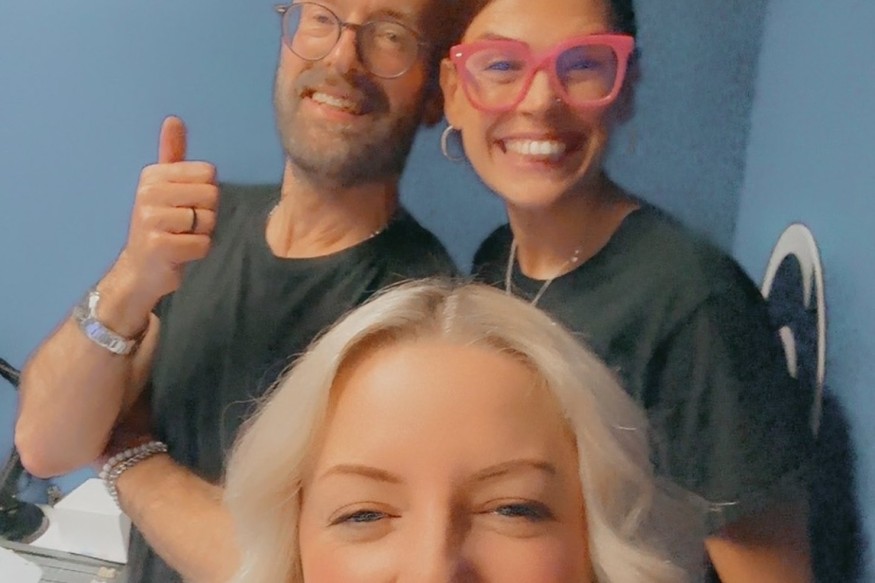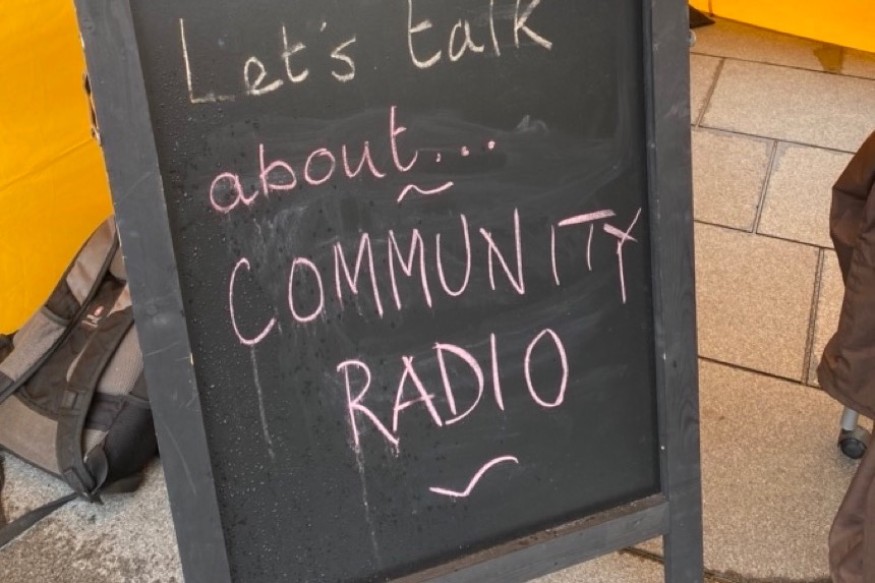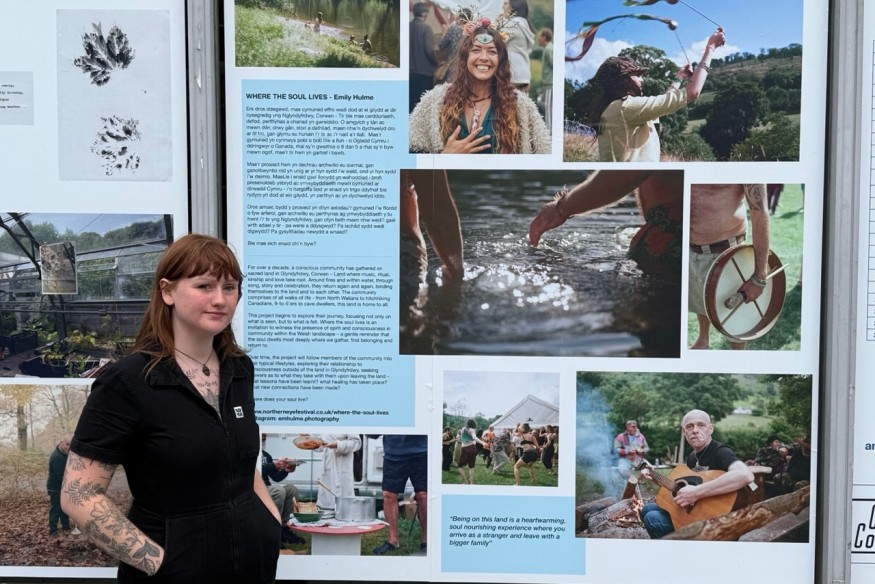Emyr and Elwyn Story Ep 05 (1982)
Producing the First Series of “Galw Gari”.
1982
After completing another pantomime tour, I returned to Colwyn Bay to find Elwyn installed in a new office. Above his shop, there was an empty office, so Elwyn decided to rent the office for a short period in order to prepare for “Galw Gari” in the hope that it would be commissioned. I arrived at the office to find that we were in need of some furniture. Two desks, four chairs, a filing cabinet and a telephone. The furniture was a priority because S4C's Commissioning Editor, Emlyn Davies, was on his way to Colwyn Bay to attend a meeting with us the following morning.
There are many benefits to working in your local area, one of the most important being getting to know a wide range of people with a variety of skills and abilities. As far as office furniture was concerned, one man came to mind, Raymond "Shone" Hughes. At the time, Raymond had a furniture shop in the town, as well as a store in Conwy Morfa. I got the whole lot from Raymond for £30! A real deal. With the necessary furniture installed, the office was ready for the meeting with Emlyn Davies the following morning.
This was another one of those protracted meetings, several of which had taken place during 1981, "Forget the film element and focus on the stand-up". However, we were all determined to fight hard to keep the film element in the programme. Following three company meetings held over the following 2 days, Elwyn phoned S4C to arrange an urgent telephone meeting with Emlyn Davies.
From the beginning of the meeting, Emyr presented a strong argument in support of the film element in the production. He added to the debate by referring to the variety of sketches that appeared in the successful Ryan and Ronnie series on the BBC in the early seventies. On the financial side, Elwyn had managed to restructure the budget of the film element, saving a considerable amount of money by tightening the schedule. At the end of a passionate and stressful meeting, Emlyn agreed to allow us to include a limited number of sketches on film in each production. We all breathed a sigh of relief, “Galw Gari” was finally, on its way!
The next step was to find a director. Several experienced people were said to want to leave their secure jobs at the BBC and HTV. Emyr also heard that some radio producers at BBC Wales were also keen to develop into the visual medium. One of these was Gareth Lloyd-Williams. Gareth had worked for a number of years with Hywel Gwynfryn, producing his popular breakfast show on BBC Radio Cymru. Emyr went to see Gareth to explain that we were working on a comedy production for S4C and that we would like to invite him to direct it. Gareth's response was positive. He mentioned that he too was considering becoming an independent producer so Emyr's offer would be of great interest to him.
The next important step was to establish a team of writers for the sketches. The names that came up, apart from Emyr, Elwyn, Glan and myself, were John Ogwen, John Gwilym Jones, Dyfan Roberts and Ifan Roberts. We met with them all to establish guidelines about the type of material we were looking for and to establish a deadline for submitting the scripts. The schedule for the year was to film the sketches during May, record the songs with the guests in October, and record the stand-up sessions by Emyr at Theatr Seilo, Caernarfon in November.
By the end of April, it was time for Cwmni r Castell to start preparing to film the sketches, so on May 4th, I started working in our office in Colwyn Bay. My priority was to establish exactly what we needed in terms of locations and artists to work with Emyr as supporting actors.
The supporting actors were easy to cast, our first choice was Mari Gwilym, she was a natural comedian and therefore, we knew she had to be included. Her performances in the pantomimes and on the radio in "Gari a Mari", were extremely professional. Our second choice was a young actor who had also worked with Emyr in the pantos, "Elibabi", and "Mwstwr y Clwstwr. His name? Ifan Huw Dafydd. In the pantos, Huw was always ready to do his very best and although he was not a great singer, he always gave one hundred per cent to every performance. Emyr also enjoyed working with both of them.
The other priority was the locations for the sketches. Although many of the sketches were not yet written, the writers had received some guidelines regarding the types of situations and locations we expected to see. Common locations, such as the Hairdressers, the Pub, the Surgery and the Supermarket. However, the biggest problem for the independent producers working in North Wales in the early days of S4C was the lack of studio facilities. The BBC and HTV were lucky enough to have their own "in-house" studio along with designers and carpenters to build whatever set was needed for the sketch.
So, how did we overcome this big problem? Well, we all have a GP, a favourite hairdresser, Pub or supermarket. And that was the simple answer. As the scripts for the first week of filming came in, we realized that we needed a Surgery, a Head Teacher's Office, a Pub and a Supermarket.
My first phone call was to my GP, Dr. Phillip Grout, to ask his permission to use his consulting room together with his desk and medical equipment such as a blood pressure monitor and examination couch. "Okay", said Dr. Grout, "the room is available every afternoon between 2 and 5 o'clock because I'm out making house calls. But you will have to be out before my evening surgery at 6 o'clock”. My next call was to my old friend, the Headmaster of Deganwy Primary School, Dennis Roberts. Dennis was also extremely cooperative, offering us his office for a day during the May half-term break. The other locations also responded positively to our requests, the pub was "The Albert" in Llandudno, the hairdresser, Gareth Evans was based in Deganwy and the supermarket, was Asda in Llandudno.
At around this time, we received a phone call from Wil Aaron, the director of the production company, “Nant Films”. S4C had been in contact with him to advise him to send his two co-directors, Robin Evans and Alun Ffred Jones on a television production training course. S4C also suggested that the course would be beneficial for Elwyn and me. This was not unexpected as far as we were concerned because of our obvious lack of experience. However, Robin and Ffred were much more experienced having worked for HTV news and were, therefore, unhappy about having to take the course. Still, this was no problem for us, so off we went to London.
“Television Training International” was a two-man operation. Andrew Quicke was the senior partner and Harris Watts, was a younger and more energetic man. Andrew had produced several religious programs for the BBC, such as "Songs of Praise". Harris Watts had directed several film reports for the BBC production, "Tomorrow's World". Andrew Quicke was a professor of media at Regent University in London and Harris had published several books on film and television techniques, but neither of them inspired confidence in Fred and Robin. They thought that, for both of them, the course was unnecessary. We agreed they were both more experienced than Elwyn and I. At the end of the course, I had to admit that Elwyn and I had learned a great deal, especially about the post-production process. Unfortunately, Ffred and Robin did not enjoy the experience and made a point of communicating their displeasure to Andrew and Harris.
At the end of September 1982, it was time for us to book our guest artists for “Galw Gari”, and to decide on the parodies to close each programme. We all agreed that every weekly guest should be a singer. Originally, we had chosen six, one for each episode, however, financial constraints brought the total down to three with two programs each. Our first choice was our old friend from the pantomime days, Sioned Mair. Next, was Eleri Llwyd and finally, a new face from Cardiff, Fiona Bennett. Elwyn contacted the girls to ask them to decide on two songs and then contacted me to discuss the arrangement, the style and the key.
The next topic for discussion was the parodies, and at this point, I believe it’s important to point out that what was acceptable in 1982 is not necessarily acceptable in the twenty-first century. This is undoubtedly true of the characters and subjects of the parodies. Neither of the songs would have been acceptable today.
The questionable songs were, "The Ballerina’s Song” and “One of Them”. The first showed Emyr dressed respectfully in a tutu admitting that he loves to dance ballet at times. In the second song, Emyr was acting as a gay hairdresser with suitable choreography and costume. The tunes were easy to choose, but finding writers for the lyrics was more difficult. The first choice was John Ogwen for the “Boy Scout’s Song”. The tune, "Dance of the Hours" by Ponchielli had been adopted by the American comedian, Alan Sherman for his song, "Hello Muddah, Hello Faddah", so that's what John wrote, but his version was much funnier.
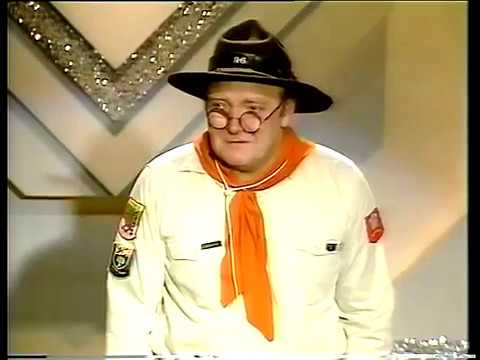
The Boy Scout
We had booked the Sain studio for six days from Saturday, 16th to Thursday, 21st October to record the songs and parodies. The following week, we recorded the multi-camera video sections of the series in front of a live audience at Theatr Seilo in Caernarfon. These pieces included the songs of the guest artists, the parodies and Emyr's "Stand Up" sessions. We recorded two episodes every night over three nights. The camera rehearsals began at 2-00 p.m. every day, the audience arrived at 7-00 p.m. and the two programmes were recorded between 7-30 and 9-30 p.m. Exactly one month later, on December 10th, the series was formally presented to S4C on time and within budget.
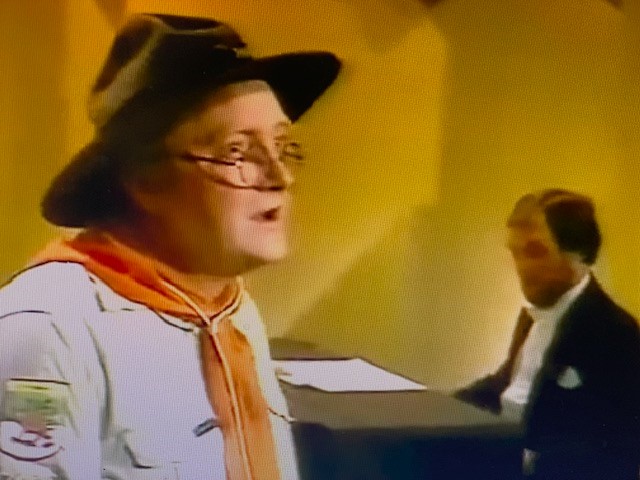
In Episode 6, the response to the first series and future plans.

